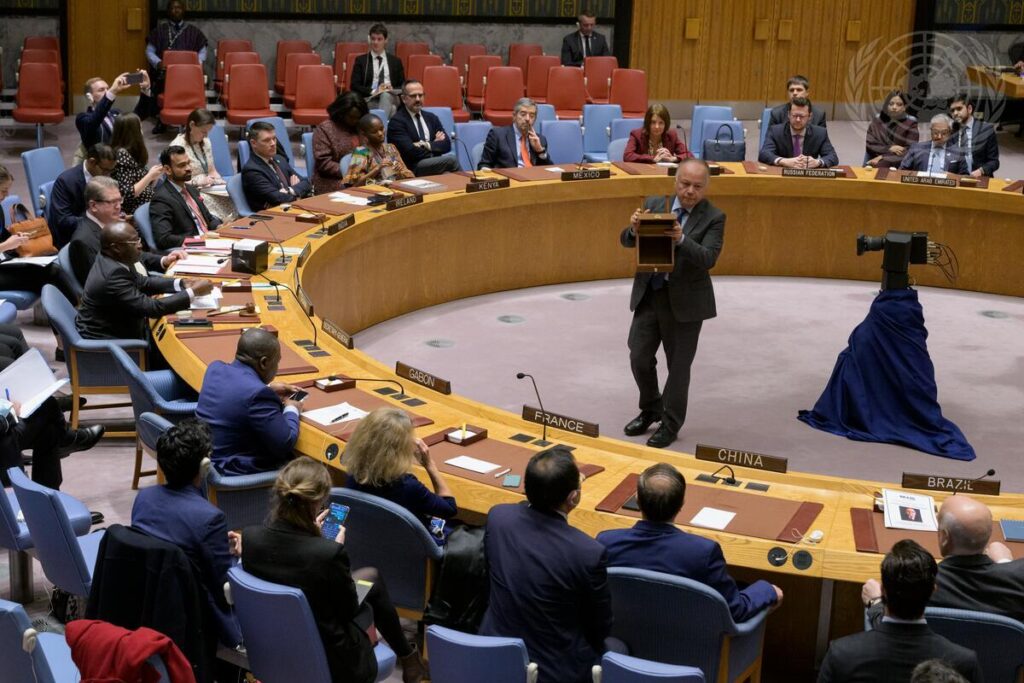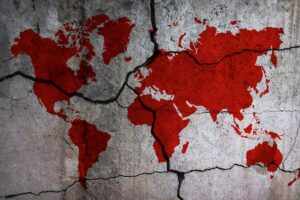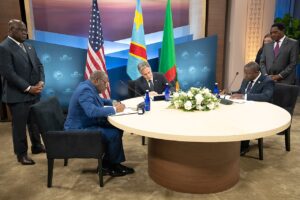The Red cell project
The Red Cell was a small unit created by the CIA after 9/11 to ensure the analytic failure of missing the attacks would never be repeated. It produced short briefs intended to spur out-of-the-box thinking on flawed assumptions and misperceptions about the world, encouraging alternative policy thinking. At another pivotal time of increasing uncertainty, this project is intended as an open-source version, using a similar format to question outmoded mental maps and “strategic empathy” to discern the motives and constraints of other global actors, enhancing the possibility of more effective strategies.
The two go-to instruments of U.S. power — military force and unprecedented sanctions — are appropriate for countering Russian President Vladimir Putin’s invasion of Ukraine. But these measures have become overworked as U.S. diplomacy has atrophied. For the United States to lead in a multipolar world, it needs to rethink how to employ the mix of hard and soft power — trade, cultural attraction, and adaptation of global multilateral institutions — that were characteristic of its broader foreign policy in the post-World War II era.
The two unrivaled instruments of U.S. national strength — the world’s most powerful military and the U.S. dollar as the global reserve currency — are losing their potency in an increasingly multipolar world. In the 21st century, both have resulted in a chain of catastrophic uses of military force (e.g., in Iraq, Afghanistan and Libya) and counterproductive sanctions, which have clearly failed to change behavior (e.g., Iran, Venezuela, and North Korea).
In light of this track record, if power is defined as the ability to attain a desired outcome, how can the United States best achieve the ends set out in its own foreign policy? Unless the point is moral opprobrium and causing increased economic pain, sanctions as the go-to tool of American foreign policy have rarely changed the undesired behaviors of bad actors. And the use of military force has been mostly counterproductive.
Nonetheless, U.S. foreign policy elites have been remarkably consistent since the promulgation of the Truman Doctrine in 1947, underestimating nationalism (e.g., in Vietnam, Iraq, and Afghanistan) with a mission to remake the world in the U.S. image. No amount of tragic failures, loss of blood, and/or even expenditures of trillions of dollars seems to have created sufficient doubt to cause these elites to reconsider how to best achieve U.S. foreign policy objectives.
This is what social scientists call path dependence: repeating behavior based on past outcomes rather than basing policy on current conditions. This strategy received another boost with the 1991 unipolar world mindset, an approach misapplied to a far more diverse and multipolar world today. The terms have changed to reflect contemporary threat actors – especially autocracies and China – but the same logic of primacy is apparent. Since the 1991 Gulf War, diplomacy has taken a back seat to exercises of blunt military and economic power. The results from this mindset are likely to produce similar calamities if not reconsidered.
All means of U.S. national power matter in an increasingly multipolar world with new forces — especially creative diplomacy — driving international politics. A rethink regarding how to apply such instruments is overdue. An appetite for U.S. leadership still exists, but of a very different type in today’s more complex world.
After World War II, the United States played a critical role in creating global institutions and public goods (including the United Nations and Bretton Woods institutions such as the World Bank and International Monetary Fund, as well as facilitating trade through the Global Agreement on Tariffs and Trade). The United States also sponsored programs like the Marshall Plan and helped to develop open markets, which were widely beneficial. As globalization and the internet took off in the latter part of the 20th century, the benefits expanded. China, India, Brazil and other developing nations, as well as many of the former Warsaw Pact states, generated a new global middle class.
That reality created a broad sense of legitimacy for American power, although it was stained by interventions like Vietnam and failed regime-change schemes. But the prosperity and security U.S. support for open markets generated, and the appeal of U.S. soft power — particularly democracy and U.S. culture — overshadowed the excesses.
Nonetheless, as wealth and power have continued to shift from West to East and North to South, globalization’s overreach, combined with the political fallout from U.S. wars in Iraq and Afghanistan, as well as the 2008 financial crisis, have taken a toll on Washington’s standing. U.S.-led international economic and political institutions are fraying and fragmenting. Moreover, developments such as the January 6th mob attack on the U.S. Capitol to overturn the results of the 2020 presidential election have further eroded America’s moral authority in much of the world. Yet, in Washington, the limits of U.S. power are not well understood.
To be sure, few better or more appealing ideas than a rules-based international system — its challenges and imperfections notwithstanding — are evident. Recent trends are troubling, however. The overly simplistic “democracy-vs.-autocracy” ideology driving U.S.-China competition is creating mirror-image reactions as China campaigns for “Asia for Asians,” and Chinese President Xi Jinping promotes a still-vague “Global Security Initiative.”
Along with the BRICS economic bloc (now expanding to include Iran and Argentina), these initiatives are China’s effort to create a counter-bloc to President Joe Biden’s fledgling alliance of democracies. Beijing, along with Moscow, is cultivating the Global South. However, the United States and China both underestimate the South’s desire to avoid such alignments (as is evident in their responses to the Ukraine war) and the Global South countries’ willingness to play the two superpowers off against each other. This dynamic risks moving the geopolitical landscape toward a more volatile, quasi-bifurcated world.
To navigate in this complex landscape, the United States needs a large dose of humility, as well as a new mental map and operating system. With 24 percent of the world’s economy, the United States needs to adapt not just to China’s re-emergence, but to the growing agency of nations in Asia, Africa, Latin America, and perhaps Europe as well.
One method for redefining the U.S. global role is engaging as primus inter pares (first among equals). That is to say, the United States should behave more like a chairman of the board than a global hegemon. In practice, doing so means employing more collaborative decision-making, but also more sharing of responsibility. Recent trends suggest a world where power is situational and open to shifting coalitions on any given issue.
Ad hoc multilateralism — networks of the willing and able — has become a key means of problem-solving as global institutions fray. U.S. alliances are still critical, but they need to operate a bit more inter pares (among equals). For example, with Asia as a top U.S. priority, Europe needs to greatly increase its military capabilities to be more central to the balance of power in the European theater. Similarly, U.S. partners in the Middle East need to assume a larger role as security providers. The evolving entente between Sunni Arab states and Israel points in that direction. A United States that accepts the limits of its power by redistributing security responsibilities, and is more selective in how it engages with the rest of the world, would be a feature of this scenario. In such a world order, Washington would play more of an offshore balancer role in areas outside of its top strategic priorities (e.g., Asia-Pacific).
This approach does not mean Biden’s effort to deepen ties with like-minded democracies is wrong. The problem is the exclusive goals embedded in this strategy. The United States, EU, Japan, South Korea, and Australia can, for example, gain political heft to shape global rules and standards if they can and agree on common policies to reform trade rules, establish standards for new and emerging technologies, and reach agreement on measures for governing outer space. Such steps, however, should not be seen as an effort to create a separate system of rules and norms excluding those outside the club, especially China.
Rather, if the United States and its like-minded partners could arrive at such a consensus (and judging from recent trade and technology dialogues, doing so would be problematic), they would have powerful leverage to negotiate global rules and norms pressing China and other outliers, which need global markets, to reform.
It is difficult to imagine a stable and prosperous world order in which the largest trading power and exporter of capital (China) and two mature nuclear weapons states in the heart of Eurasia (China and Russia) are isolated and kept outside some framework that factors in their interests.
This risk of a world nearly spinning out of control was summed up by former Secretary of State Henry Kissinger, who told the Wall Street Journal in a recent interview, “We are at the edge of war with Russia and China on issues which we partly created, without any concept of how this is going to end or what it’s supposed to lead to.”
Although it’s difficult to envision how or when the needed paradigm shift in the U.S. approach to foreign policy might occur, such a shift needs to start with reexamining the role of Washington’s two primary instruments of power – military and economic clout – and their efficacy for achieving U.S. foreign policy goals in a multipolar world.




